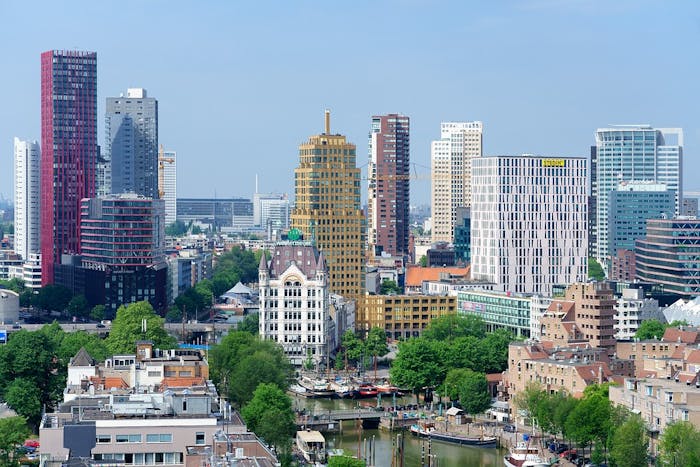This comprehensive approach increases the city’s resilience on a district level. It anticipates the consequences of climate change, improves the quality of public space, and also contributes to improving the social cohesion of the community. Several examples of this approach have been implemented in Rotterdam; three of these are explained below.
1. The Benthemplein water square
The world’s first large-scale water square has accomplished two goals: during heavy rain it captures a large quantity of water and returns it to nature, and it enhances the appearance of the city. The water square was designed according to an intensive participation process. During rainfall, water is collected in 3 basins. The accumulated water is then drained into the soil or is funneled to a nearby canal. The 3 basins hold up to 1.7 million liters of water (1,700 m3). This model is now being expanded to more squares in Rotterdam and other cities worldwide.
2. Multifunctional rooftop programme
A unique roof landscape is evolving above the city. The surface area of the flat roofs in Rotterdam is about 15,000,000 m2. The possibilities to use the roofs for climate adaptation are endless: to make Rotterdam a greener city, as a water buffer, for the generation of sustainable energy, and as new places for people to meet.
The future roof landscape in Rotterdam will consist of so-called green, blue, red, and yellow roofs. Each color represents a particular function: yellow for solar energy, green for vegetation on roofs, and blue for extra water storage. Red roofs have a social function; more and more, roofs are being used as meeting places. This is a necessary expansion of public spaces in cities, which are becoming more congested because of densification.
3. Global Centre of Excellence on Climate Adaptation
In Rotterdam, a Global Centre of Excellence on Climate Adaptation is established. The Centre will support those that have the ambition to put climate adaptation effectively into practice, in all parts of the world. It will collect lessons learned from recently executed policies, programs and projects and use them to develop guidance to accelerate climate adaptation. Consequently, it will be used to support countries, communities and companies to successfully integrate climate adaptation into their investment decisions.
![]() Municipality Rotterdam
Municipality Rotterdam

 11 Sustainable Cities and Communities
11 Sustainable Cities and Communities
 06 Clean Water and Sanitation
06 Clean Water and Sanitation
 13 Climate Action
13 Climate Action